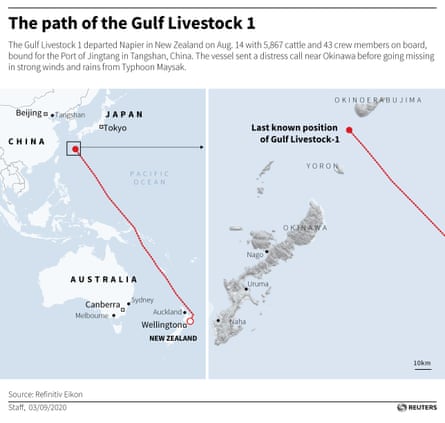New Zealand has suspended live cattle exports after a ship carrying almost 6,000 animals sank off the Japanese coast on Wednesday. There are growing fears for the fate of the more than 40 crew members on the Gulf Livestock 1, with reports of just one survivor so far.
The vessel was on its way to China when it reportedly developed engine problems and sank in rough seas caused by Typhoon Maysak, the survivor said.
The rescued Filipino crew member was recovered after a Japanese navy P-3C surveillance aircraft spotted him wearing a life vest and waving while bobbing in the water.
The member, named as Eduardo Sareno, a 45-year-old chief officer, told rescuers that the ship stalled when an engine stopped, then capsized after being hit by a powerful wave, said Japanese coast guard regional spokesman Yuichiro Higashi.

The crew comprises 39 Filipinos, two Australians and two New Zealanders, the Kyodo news agency said.
One of the missing Australians is Lukas Orda, 25, of Queensland, who was working on the live export ship as a veterinarian, a job he had only begun in June after leaving a horse veterinary practice on the Gold Coast.
Michael Lowcock, a Catholic priest from the town of Mount Isa in Queensland, said Orda’s family were “very devastated” by news the ship had sunk. He said Orda, with his wife Emma, had recently had their first child – a son named Theo. Orda’s parents are both well known doctors in their community.
The wife of another crew member, Liezel Pitogo, said she last spoke to her husband, Lindon, on Tuesday night. She told the BBC he had said they were travelling to China but they were worried about the weather.
“His phone was unreachable on Wednesday,” said Pitogo, 38, from the Quezon province of the Philippines. “I thought it’s just a problem with the erratic signal when they are on the sea but I saw a Facebook post from a seaman’s wife about a cargo ship that went missing so I started contacting and asking some of the other wives.”
The Gulf Livestock 1 was registered under a Panamanian flag and is owned by Gulf Navigation Holding, based in the United Arab Emirates. It left Napier in New Zealand on 14 August with 5,867 cattle onboard, New Zealand’s foreign ministry told Reuters. The vessel was bound for Jingtang in Tangshan, China, on a journey that should have taken 17 days.
Although New Zealand has not exported livestock for slaughter since 2016, animals are sold abroad for breeding.

A statement from New Zealand’s Ministry of Primary Industries (MPI), which governs exports, said it had “temporarily suspended consideration of cattle livestock export applications after a vessel transporting stock from New Zealand to China went missing off the coast of Japan. MPI wants to understand what happened on the sailing of the Gulf Livestock 1.”
The MPI spokesperson denied reports there were pregnant cattle on board.
Livestock ships are often owned and managed by different companies and name changes are common. The Gulf Livestock 1, previously named Rahmeh, Cetus J, Dana Hollandia and Maersk Waterford, is currently managed by a German company, MC-Schiffahrt.
The company would not answer questions by phone about the ship or the circumstances in which it sank. The person answering the phone at MC-Schiffahrt pointed instead to an online statement that said it “lost contact to one of the vessels under our technical management, MV Gulf Livestock 1 … having been on her way from New Zealand to China and having crossed Typhoon Maysak in the chinese [sic] sea.”
The statement added that since 2 September “contact to the vessel is lost and a distress signal was received” and it hoped that Japanese rescue efforts “will bring positive results soon. Relevant authorities have been informed accordingly. Our thoughts are with our crew and their families”.
Shipping website Equasis shows the Gulf Livestock 1 was detained on 22 May 2019 in the Australian port of Broome with seven deficiencies. It was kept for three days and deficiencies listed include two “safety of navigation” defects and one labour conditions fault.
Another livestock ship owned by Gulf Navigation Holding, Gulf Livestock II, which also sails under a Panamanian flag, was detained in May 2019, according to the European Maritime Safety Agency portal. Detention issues included the improper maintenance of weather-tight conditions, fire safety equipment not being “as required” and missing pollution prevention paperwork. The detention lasted five days. Gulf Navigation Holding offices in Dubai were closed when contacted by the Guardian.
A spokesperson for the European Maritime Safety Agency said the Gulf Livestock 1 was built in 2002, is 18 years old and has been “inspected quite often in the Pacific area, with 10 inspections in the last year in Australia and or other Tokyo MoU [memorandum of understanding] countries”, and that details can be found in the Paris MoU inspection database using the ship’s unique IMO number, 9262883. The spokesperson said that although “deficiencies were found almost every time, it was only detained once on 22 May 2019 in Australia”.
